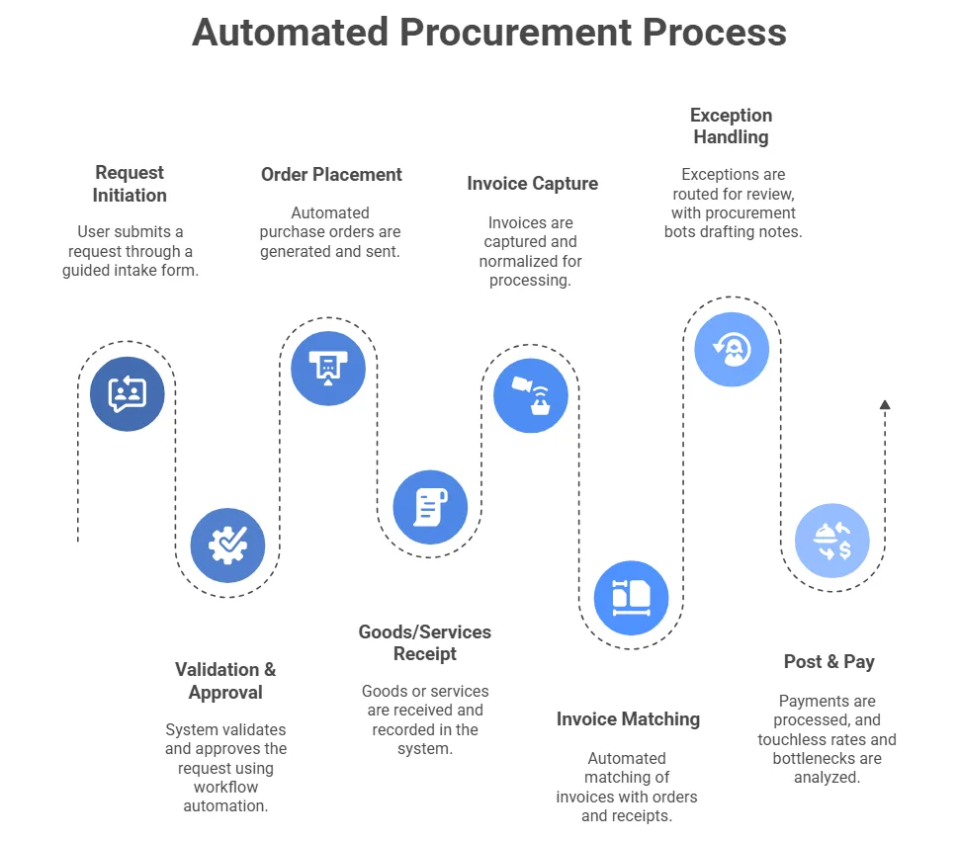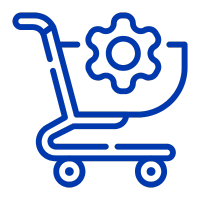Procurement Automation refers to the use of technology to streamline and optimize the procurement process, by automating repetitive tasks, improving accuracy, and enhancing efficiency. This involves deploying software systems to manage activities such as sourcing, negotiations, contract management, and spend analysis, reducing manual intervention and enabling procurement teams to focus on strategic tasks that add greater value to the organization.
Read more: How Procurement Automation can help in the Enterprise transformation?
Why Organizations Adopt Procurement Automation
Email chains and manual spreadsheets don’t scale. With workflow automation, automated approvals, and light procurement bots, cycle times drop, errors shrink, and policy is enforced in the flow instead of after the fact.
How Procurement Automation Works: End-to-End Process
A requester uses a guided form. The system checks budget and policy, applies automated approvals, and converts the requisition into an automated purchase order. Suppliers receive POs, confirm, and ship. Receipts are logged; invoices arrive via e-channels or capture. Matching runs automatically; exceptions go to the right person with context. Under the hood, rules and robotic process automation (RPA) handle screen-level tasks where APIs don’t exist, while procurement bots answer quick questions (“Where’s my PO?”) or prefill routine data.
Download Research Report: Robotic Process Automation in Procurement What leaders need to know about?
Quick vignette.
Before automation, AP spent hours keying invoices and chasing approvers. After go-live, PR→PO happened in minutes, touchless procurement invoices posted straight through, and exception queues were small enough to clear daily.
Read more: Crafting a Future-Proof Procurement Automation Strategy: A Guide for Fortune 500 Leaders
Key Facts About Procurement Automation
- Also called: P2P automation, purchasing automation
- Who uses it: requesters, buyers, approvers, AP, suppliers
- Goal: faster cycles, fewer touches, cleaner compliance
- Typical metrics: PR→PO time, touchless invoice rate, first-pass match %, exception aging, on-contract %
- Core capabilities: workflow automation, automated approvals, automated purchase orders, receipt logging, invoice capture/match, procurement bots, RPA for gaps
What Good Procurement Automation Looks Like
One front door. Every buy starts in the same place; the system chooses the right path (catalog, contract, or spot).
Policy in the flow. Budgets, thresholds, and approvers apply automatically—no side emails.
Touchless where safe. Low-risk, well-coded transactions flow straight through, true touchless procurement while exceptions are surfaced early with owners and due dates.
AP that just works. Clean master data + matching rules = fewer errors, faster close.
Bots that help, not hinder. Small procurement bots fill forms, fetch status, and summarize exceptions; people make the calls.
Tangible Benefits of Procurement Automation
- Cycle times shrink thanks to automated approvals and PR→PO conversion.
- Error rates fall as coding, catalogs, and matching replace manual entry.
- Compliance improves because policy is enforced automatically.
- AP productivity jumps via touchless posting and clear exception queues.
- Supplier experience improves with predictable POs and faster payments.
- Stakeholders get visibility—status and spend without chasing.

Key Terms in Procurement Automation
- Robotic process automation (RPA): screen-level automation when no API exists.
- Procurement bots: lightweight assistants that fetch data, prefill fields, and answer status/policy questions.
- Automated approvals: rules-driven routing based on policy, value, and risk.
- Touchless procurement: transactions that require no human touch from request to post.
- Workflow automation: orchestration of steps, owners, timers, and SLAs.
- Automated purchase orders: system-generated POs from approved requisitions.
The Role of AI in Procurement Automation
AI can suggest the right buying path, auto-code lines, flag duplicates or price outliers, summarize exception threads, and predict which invoices will fail match—while humans approve policy changes, pick suppliers for higher-risk buys, and close escalations.
Read more: Revolutionizing Procurement: Agentic AI-Driven Autonomous Purchase Orders & Automation
FAQs
Q1. What is procurement automation?
Using workflow automation, automated approvals, procurement bots, and RPA to remove manual steps from requesting, ordering, receiving, and paying—improving speed and compliance.
Q2. Benefits of RPA in procurement?
RPA fills integration gaps: log into legacy portals, download confirmations, upload POs, and copy data between systems—reducing swivel-chair work and errors.
Q3. How do I reduce manual procurement tasks with automation?
Standardize intake and catalogs, turn policies into routing rules, enable PR→PO automated purchase orders, and push clean matching with tolerances. Measure touchless rates and fix the top three exception causes.
Q4. What are automated approval workflows?
Rules that route requests to the right approvers based on value, category, location, or risk. Escalations and timers prevent stalls; audit logs make decisions traceable.
Q5. Is touchless procurement realistic?
Yes for well-coded, low-risk buys (catalog items, recurring services). Keep humans in the loop for high value, novel specs, or risky suppliers.
Q6. Where should we start?
Pick one quick-win chain (catalog PR→PO→receipt→e-invoice→match). Prove touchless procurement there, then expand to complex categories with tighter controls.
References
Explore Zycus resources to learn more about Procurement Automation:
- You Probably Didn’t Know these 6 Procurement Myths
- Working Capital Management: How can procurement help?
- Exploring the Impact of Generative AI on Procurement at Horizon
- Automation in Engineering & Manufacturing Procurement
- Enabling The Procurement Function To Assume A Strategic Role Through Automation
- Automating a Mess Just Makes a Faster Mess: 4 Common Pitfalls to Avoid
- Stop Automating, Start Orchestrating: AI Isn’t Your Savior Yet






















































